Featured Comment
Just made this and it was easy and delicious! Thanks!
– @darinsf5281 (from YouTube)
Ever wonder how Japanese kitchens stay stocked with side dishes for our spread that taste good (or even better) all week?
We rely on jōbisai (常備菜) small side dishes like kinpira gobo, hijiki salad, and chikuzenni that keep well in the fridge. This simmered kiriboshi daikon is definitely one of these meal prep friendly jōbisai that you can enjoy over several days!

Simmered kiriboshi daikon
Recipe Snapshot
- What is it? Simmered dried daikon steeped in soy and mirin, rich with umami from its own soaking broth.
- Flavor profile: Sweet-savory, Umami-rich, Earthy
- Why you’ll love this recipe: It turns that intimidating bag of dried daikon into a repeatable staple you can confidently rotate through.
- Must-haves: Kiriboshi daikon, Soy Sauce + Mirin
- Skill Level: Easy
- Freezer Friendly? Yes!
- Suitable for Meal Prep? Yes!
Summarize & Save this content on:
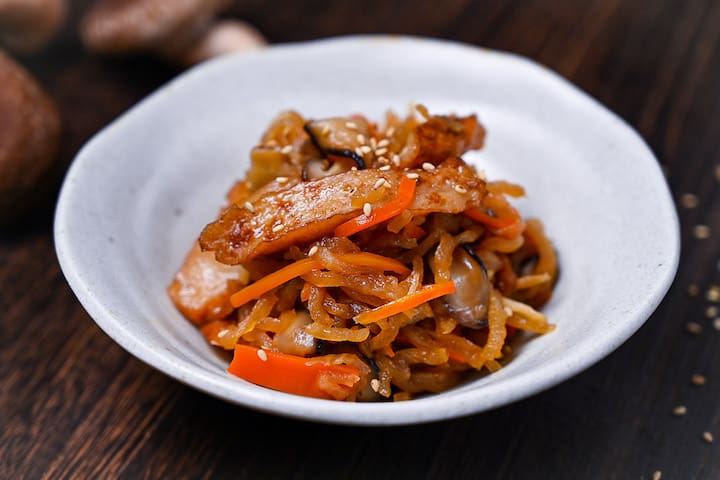
What is Simmered Kiriboshi Daikon
Kiriboshi Daikon no Nimono (切り干し大根の煮物) is a classic Japanese side dish made by simmering rehydrated kiriboshi daikon (sun-dried strips of daikon radish) in a sweet-savory mix of dashi, soy sauce, and mirin. Drying the radish actually concentrates its flavor, giving this dish its signature gentle sweetness and chewy texture.
Once a clever way to preserve vegetables through the Edo period (1603-1868) winters, it’s now a staple jōbisai, a make-ahead dish that keeps beautifully for several days in the fridge to be used as a side or in a bento box.
Simmered Kiriboshi Daikon Ingredients
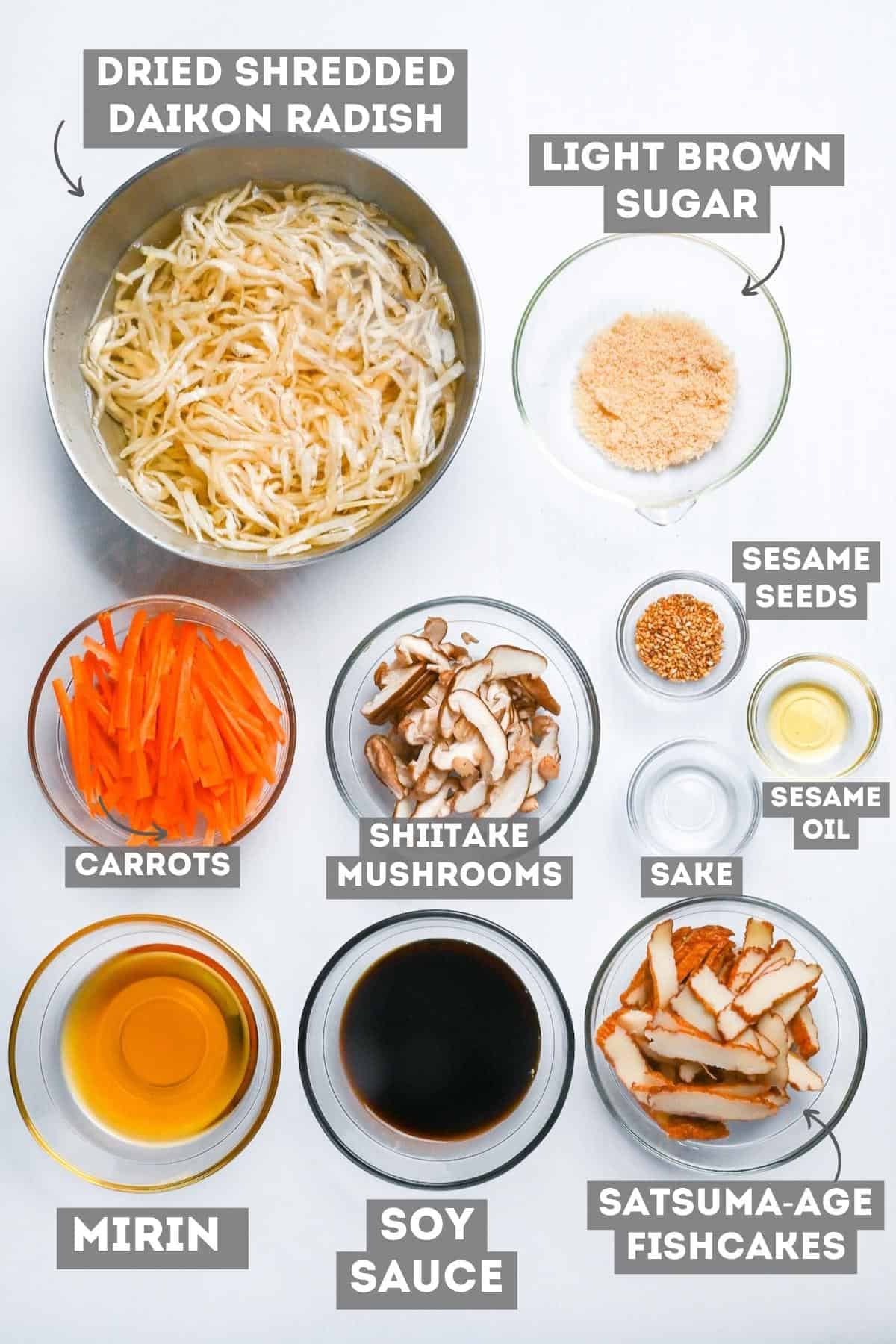
- Kiriboshi daikon (dried shredded daikon radish): Sun-dried daikon cut into fine strips that rehydrate quickly into tender-chewy threads with a gentle, sweet-savory snap. Look for it in the dried-vegetable aisle at well-stocked Asian grocers or Japanese markets.
- Carrot: Thin carrot matchsticks add bright color and a familiar, mellow sweetness that plays beautifully with savory broth.
Substitutions/Variations
- Instead of carrot: Use thinly sliced bell pepper or green beans cut into matchsticks, both add visual pop. Note that you’ll lose some of carrot’s natural sweetness, so taste and add a pinch more sugar if needed.
- Instead of satsuma-age (fish cake): You can use other Japanese fish cakes like chikuwa (tube-shaped fish cake) or kamaboko. Or try Korean fish cakes (eomuk/odeng). For a non-fish option, try sliced fried tofu pouches (aburaage) work great.
- Vegetarian version: Skip the fish cake and use aburaage or atsuage tofu instead.
Have trouble finding Japanese ingredients? Check out my ultimate guide to Japanese ingredient substitutes!
How to Make My Simmered Kiriboshi Daikon
If you prefer to watch the process in action, check out my YouTube video of this kiriboshi daikon recipe!
i. Pour the kiriboshi daikon into a bowl, cover with cool water, and massage-wash. Drain and repeat 3 times until the water runs mostly clear. This knocks off dust and the slightly oxidized aroma so the finished dish tastes clean.

ii. Add 300 ml fresh water to the bowl, drop in dried shiitake, and soak for 20 minutes.
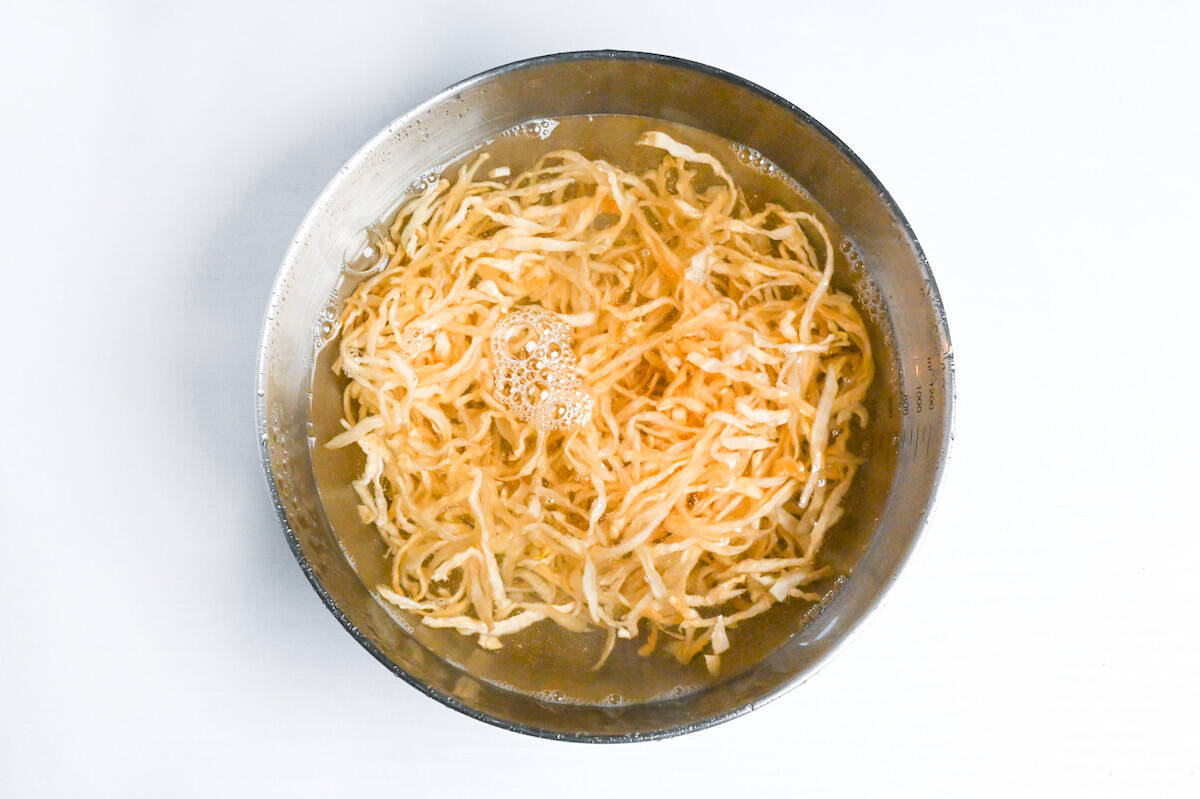
iii. Drain kiriboshi daikon and squeeze it firmly over the bowl to catch all the soaking liquid, we will use this in a later step.
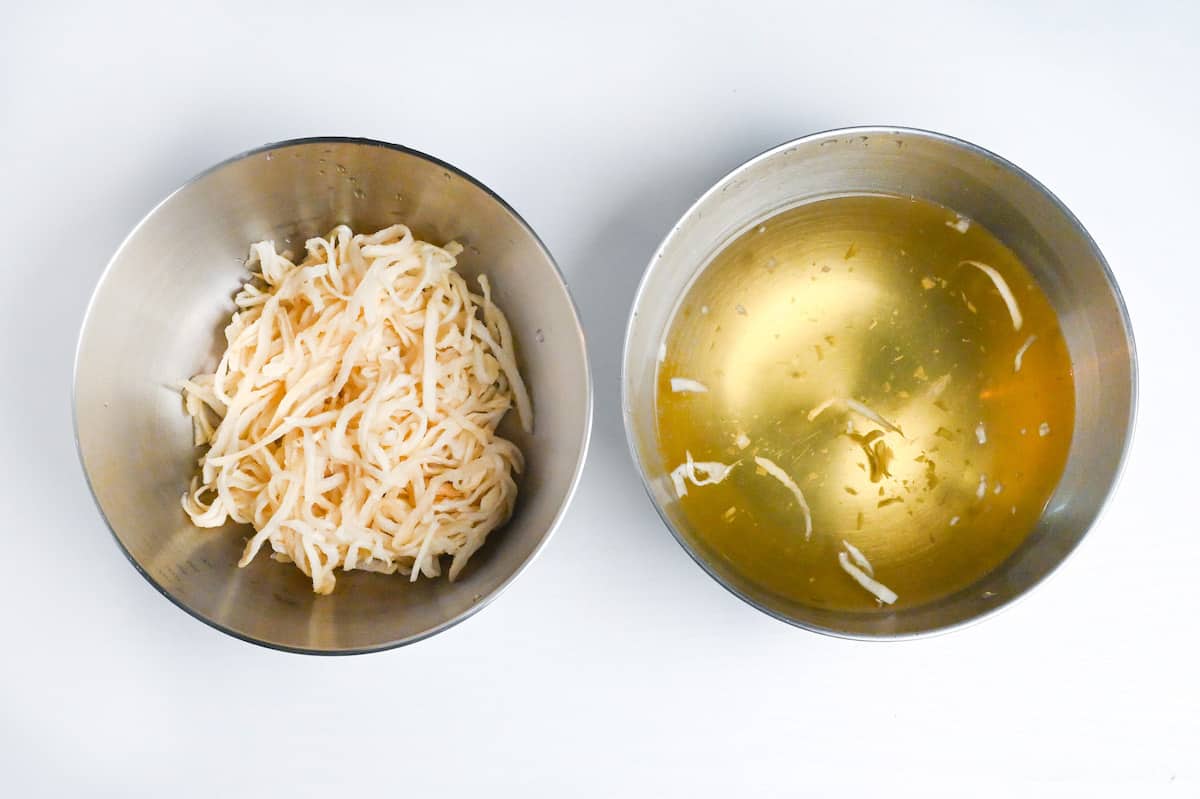
The liquid is packed with guanylate-rich umami from dried shiitake and boosts flavor.
iv. If the kiriboshi daikon pieces are too long, cut them into thirds using scissors. This will make it easier to eat.
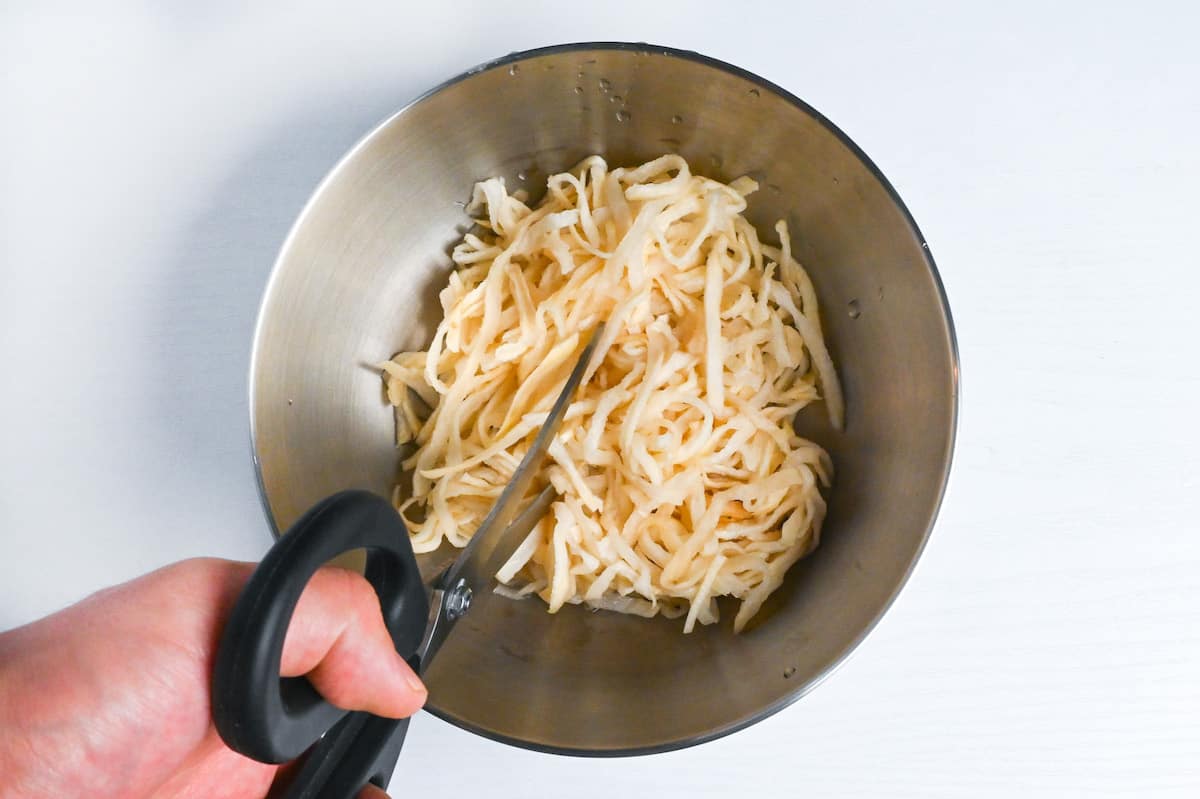
iv. Julienne carrot to the same thickness as the kiriboshi and slice both the rehydrated shiitake and fresh shiitake to similar widths.
v. Set satsuma-age in a sieve and pour over just-boiled water 95-100 ℃ (203-212 °F) to rinse off surface oil. Pat dry, then slice to match the shiitake. A quick de-oil prevents greasy broth and helps flavors soak in.
i. Film a wide pan with neutral oil over medium heat until it shimmers, then add the carrot, the fresh shiitake, and the sliced rehydrated shiitake. Sauté 2-3 minutes until the mushrooms look glossy and the carrot edges turn brighter orange.
ii. Add the drained kiriboshi and sliced satsuma-age. Toss 1 minute to coat everything in hot oil.

iii. Pour in all the strained soaking liquid, sake, and light brown sugar, stir to dissolve. Bring to a gentle simmer. Aim for 85-95 ℃ (185-203 °F) with tiny bubbles rising lazily.

Then hold that simmer 5 minutes to let sweetness permeate the daikon. Boiling hard can toughen textures and drive off aroma, so keep it shy of a full boil.
i. Pour in soy sauce and mirin, stir, and simmer 3-5 minutes more.
ii. Simmer until the liquid is almost gone and just lightly sheens the strands. The pan should sound more sizzly than splashy.
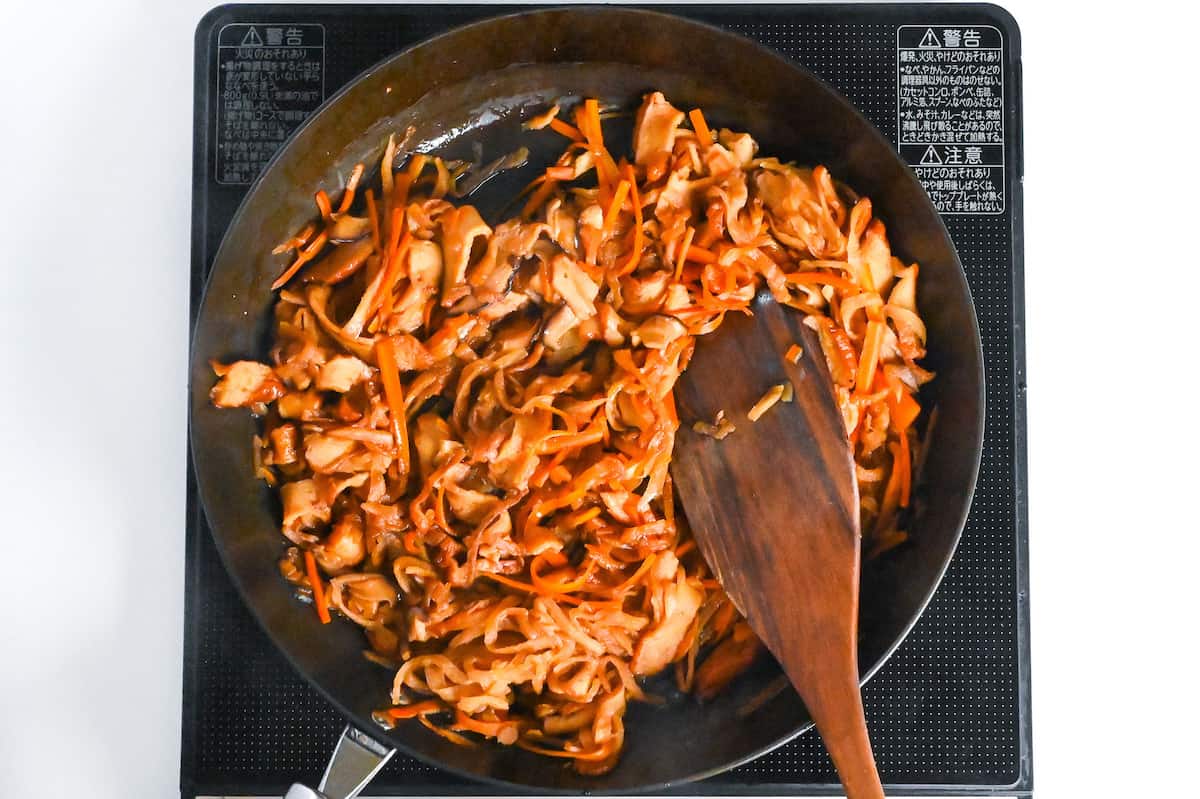
Now is the time to taste and adjust: for more savoriness add a bit of soy sauce, for rounder sweetness add a pinch of sugar.
iii. A drizzle of toasted sesame oil and fold. Off heat, let it stand 5-10 minutes so flavors settle and soak in as it cools.
iv. Plate warm, at room temp, or cold. Sprinkle toasted white sesame.

If you leave the simmered kiriboshi daikon to cool down first, the flavors soak deeper into the ingredients and create a better taste overall.

Essential Tips & Tricks
- Save every drop of soaking liquid. That pale water holds dissolved umami from the daikon and shiitake.
- Squeeze the daikon firmly after soaking. If it’s dripping wet when it hits the pan, you’ll dilute your seasonings and end up with watery.
- Add soy sauce and mirin only after the first simmer. If you pour them in too early with the sugar and sake, the soy can turn bitter and the mirin’s sweetness burns off before it has a chance to glaze properly.
- Stop cooking when a thin glaze remains, not bone-dry.
- Taste before you finish. Everyone’s soy sauce brand has a different salt level, so always sample a piece of daikon after adding the final seasonings and adjust with an extra teaspoon of soy if needed.
With these simple tips in mind, you’re set for success every time you make simmered kiriboshi daikon.
Storage & Meal Prep
Fridge: Airtight container with some braising liquid still coating the ingredients, 3-4 days. Day 2 often tastes better than day one.
Freezer: Airtight container or freezer bags in single-serving portions with liquid, up to 1 month.
Meal Prep: This dish is built for batch cooking. Make the full recipe on a Sunday to enjoy throughout the week, let it cool completely (flavor develops as it cools), then portion into containers or one large storage container. For even better flavor integration, refrigerate overnight before the first serving as a side dish.
Reheating: You can enjoy this side dish cold. Frozen portions can go straight from freezer to microwave or thaw overnight in the fridge.
What to Serve With This Recipe
- Grilled salted salmon (shiozake)
- Salt-grilled mackerel (saba no shioyaki)
- Ginger pork (shogayaki)
- Traditional miso soup
Simmered Kiriboshi Daikon Q&A
Kiriboshi daikon is daikon radish that’s been julienned and sun-dried until all moisture evaporates. This ancient preservation method concentrates nutrients, sweetness, and umami into lightweight strands that rehydrate in minutes. The drying process triggers enzyme activity and sun exposure that increases glutamic acid and GABA, giving it a deeper, earthier flavor than fresh daikon. Even after rehydrating, the texture stays pleasantly chewy rather than crisp. You’ll never mistake it for raw radish.
Some brands have a stronger sun-dried funk, especially if made with daikon skin. Eliminate it by doing three thorough rinse-and-squeeze cycles before soaking, or blanch the rinsed daikon in the second rice-washing water (or plain water with a pinch of uncooked rice) for 1-2 minutes, then drain and proceed.
Sake can be omitted, but mirin is harder to replace. It’s not just sweet, it adds gloss and a fermented depth that balances the soy for this dish.
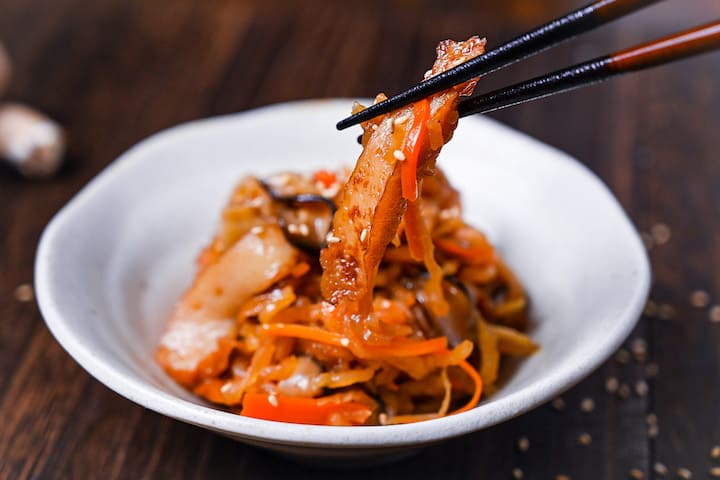
More Japanese Side Recipes
- Crispy Agedashi Tofu
- Nasu Dengaku (Miso Eggplant)
- Simmered Soybeans and Vegetables (Gomoku-Mame)
- Japanese Potato Salad
Looking for simple ways to round out your Japanese dinner? Check out these easy Japanese side dishes!
Did You Try This Recipe?
I would love to hear your thoughts!
💬 Leave a review and ⭐️ rating in the comments below. 📷 I also love to see your photos – submit them here!
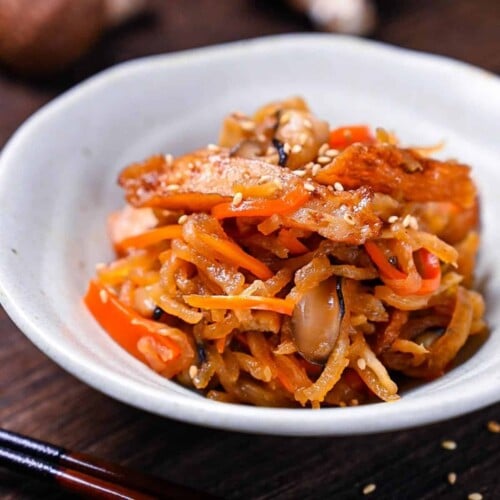
Simmered Kiriboshi Daikon Radish
Ingredients
- 50 g dried shredded daikon (kiriboshi daikon)
- 300 ml cold water for soaking
- 1 dried shiitake mushroom
- 100 g satsumaage fishcake for plant-based, sub 2 sheets aburaage, julienned
- 1 tsp cooking oil
- 1 carrot medium size, approx 75g each julienned
- 2 fresh shiitake mushroom julienned
- 1 tbsp sake
- 1 tbsp light brown sugar
- 3 tbsp Japanese soy sauce (koikuchi shoyu)
- 3 tbsp mirin
- toasted sesame oil
- toasted white sesame seeds optional garnish
My recommended brands of ingredients and seasonings can be found in my Japanese pantry guide.
Can’t find certain Japanese ingredients? See my substitution guide here.
Instructions
- Place 50 g dried shredded daikon (kiriboshi daikon) in a mixing bowl and cover with cold water. Wash the daikon by rubbing it with your hands and then discard the water. Repeat 3 times in total.

- After the third time, pour 300 ml cold water into the bowl and add 1 dried shiitake mushroom. Leave to soak for 20 minutes.

- Place a sieve over a heatproof bowl and arrange the 100 g satsumaage fishcake in a single layer. Pour freshly boiled water over the surface to remove the oil, then pat dry and thinly slice them.
- After the 20 minute resting time, lift the daikon and shiitake from the water and squeeze them thoroughly over the bowl, saving the golden broth for later.

- If the kiriboshi daikon pieces are too long, cut them into thirds. Thinly slice the rehydrated shiitake mushroom.

- Heat a large frying pan on medium and add 1 tsp cooking oil. Once hot, add 1 carrot, 2 fresh shiitake mushroom and the rehydrated shiitake to the pan. Stir fry for 2-3 minutes.

- Add the daikon and fish cake slices to the pan and stir fry for another minute.

- Pour in the leftover daikon broth from earlier along with 1 tbsp sake and 1 tbsp light brown sugar. Mix and simmer for 5 minutes or until the liquid is almost gone.

- Add 3 tbsp Japanese soy sauce (koikuchi shoyu) and 3 tbsp mirin. Continue to cook until mostly reduced. Taste test and add a touch more soy sauce or sugar to taste, then turn off the heat and drizzle with toasted sesame oil.

- Leave to cool slightly, then serve or store. Sprinkle with toasted white sesame seeds right before serving. Enjoy!

Video






Authentic and delicious!
Thank you, Mia!
Yuto